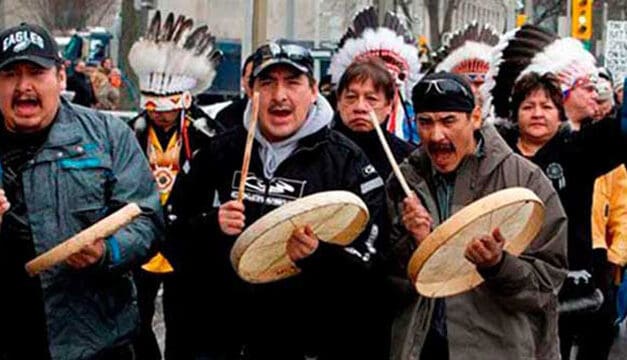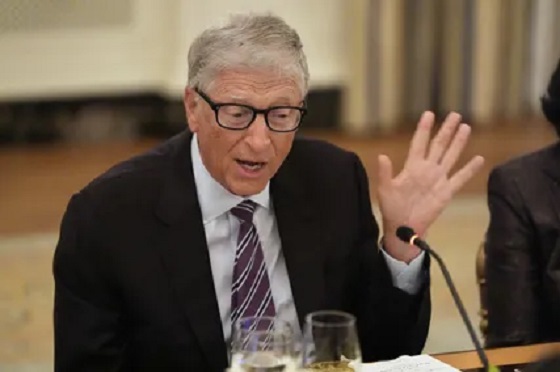Frontier Centre for Public Policy
UBCIC Chiefs Commit A Grave Error In Labelling Authors As Racist Deniers

From the Frontier Centre for Public Policy
By Rodney A. Clifton
UBCIC Chiefs attempt to suppress open debate on residential schools.
Is anyone surprised that the Union of BC Indian Chiefs on Aug. 12 wrote to many provincial municipalities (Powell River, Kamloops, and Quesnel, for example) demanding they reject “Residential School Denialism”?
Their demand is in response to a book edited by C.P. Champion and Tom Flanagan, Grave Error: How the Media Misled Us (and the Truth about Residential Schools). The authors of the 18 chapters include several well-known Canadian anthropologists, historians, political scientists, sociologists, and lawyers, many of whom have published extensively on Indigenous/non-Indigenous issues.
Even so, the organization of Chiefs call this book an “ardent dissemination of racist misinformation.”
Their letter to municipal leaders concludes with the following:
“The UBIC Chiefs Council stand with survivors and intergenerational survivors of Residential Schools and their families, as well as the children who never made it home and those who are harmed by the actions of those involved with the production and distribution of the book … and the deeply troubling trend of Residential School racist denialism and any unwillingness to accept facts and the work of experts.”
“We look forward to your response.”
As an author of a chapter in Grave Error, as co-author of two other chapters, and as a co-editor with Mark DeWolf of From Truth Comes Reconciliation: An Assessment of the Truth and Reconciliation Commission Report, I am pleased to respond to the Chiefs.
My recommendation to municipal leaders, and other concerned Canadians, is that before you respond to the Chiefs, you should read Grave Error and make up your up your own minds.
On Amazon, Grave Error has over 800 reviews, with an average rating of 4.6 out of 5. In fact, this book is ranked first on three Amazon lists, and it has been a best seller for many months.
One of the top Amazon reviews begins, “A well-researched, non-partisan and balanced approach to the hysterical outpourings of recent years.” Another review says, “There is not one whiff of racism or hatred in this book.”
As a contributing author to Grave Error, I will add a little of my history.
I lived for four months during the Summer of 1966 in the teachers’ wing of Old Sun, the Anglican Residential School on the Siksika (Blackfoot) First Nation in Southern Alberta. At the time, students were still in residence, and I was a 21-year-old university student intern working at the Band Office, where about half the employees were Siksika members. Also, most of the employed in Old Sun, where I lived, were Siksika.
In the fall of 1966, I became the Senior Boys’ Supervisor in Stringer Hall, the Anglican residence in Inuvik, NWT, where I looked after 85 mostly Indigenous boys in three dorms. About half of the employees in this residence were Indigenous.
I returned to the University of Alberta for the 1967-68 academic year, and in the summer of 1968, I was employed as the Beach Supervisor and Swimming Instructor in Uranium City, Northern Saskatchewan, where I taught swimming to many Indigenous children in a local lake.
Finally, in September 1968, Elaine Ayoungman, a young Siksika woman I met in 1966, and I were married in the Anglican Church in Strathmore, Alberta. Elaine had been a student in Old Sun for 10 years, and this September, we will celebrate our 56th wedding anniversary. We are still married, and, no doubt, surprisingly to the BC Chiefs, we are still in love.
By now, readers will realize that I strongly reject the UBCI Chiefs’ claim that I, or any of the other authors with chapters in Grave Error, are “racist deniers” of the reality of Indian Residential Schools.
In short, my message to the BC municipal leaders is to resist echoing the opinion of the UBCIC, me, or the opinions of over 80 percent of the reviews on Amazon who awarded the book a 4 or 5. My message is simple: Read Grave Error and make up your own mind. Likewise, my message to Canadians who want to know more about Indian Residential Schools is to listen to the survivors and Chiefs but also read the Truth and Reconciliation Report and then read both Grave Error and From Truth Comes Reconciliation.
Rodney A. Clifton is a Professor Emeritus at the University of Manitoba and a senior fellow at the Frontier Centre for Public Policy. His most recent book, with Mark DeWolf, is From Truth Comes Reconciliation: An Assessment of the Truth and Reconciliation Commission Report (Sutherland House Press, 2024). The book can be preordered from the publisher.
Frontier Centre for Public Policy
Tent Cities Were Rare Five Years Ago. Now They’re Everywhere

From the Frontier Centre for Public Policy
Canada’s homelessness crisis has intensified dramatically, with about 60,000 people homeless this Christmas and chronic homelessness becoming entrenched as shelters overflow and encampments spread. Policy failures in immigration, housing, monetary policy, shelters, harm reduction, and Indigenous governance have driven the crisis. Only reversing these policies can meaningfully address it.
Encampments that were meant to be temporary have become a permanent feature in our communities
As Canadians settle in for the holiday season, 60,000 people across this country will spend Christmas night in a tent, a doorway, or a shelter bed intended to be temporary. Some will have been there for months, perhaps years. The number has quadrupled in six years.
In October 2024, enumerators in 74 Canadian communities conducted the most comprehensive count of homelessness this country has attempted. They found 17,088 people sleeping without shelter on a single autumn night, and 4,982 of them living in encampments. The count excluded Quebec entirely. The real number is certainly higher.
In Ontario alone, homelessness increased 51 per cent between 2016 and 2024. Chronic homelessness has tripled. For the first time, more than half of all homelessness in that province is chronic. People are no longer moving through the system. They are becoming permanent fixtures within it.
Toronto’s homeless population more than doubled between April 2021 and October 2024, from 7,300 to 15,418. Tents now appear in places that were never seen a decade ago. The city has 9,594 people using its shelter system on any given night, yet 158 are turned away each evening because no beds are available.
Calgary recorded 436 homeless deaths in 2023, nearly double the previous year. The Ontario report projects that without significant policy changes, between 165,000 and 294,000 people could experience homelessness annually in that province alone by 2035.
The federal government announced in September 2024 that it would allocate $250 million over two years to address encampments. Ontario received $88 million for ten municipalities. The Association of Municipalities of Ontario calculated that ending chronic homelessness in their province would require $11 billion over ten years. The federal contribution represents less than one per cent of what is needed.
Yet the same federal government found $50 billion for automotive subsidies and battery plants. They borrow tonnes of money to help foreign car manufacturers with EVs, while tens of thousands are homeless. But money alone does not solve problems. Pouring billions into a bureaucratic system that has failed spectacularly without addressing the policies that created the crisis would be useless.
Five years ago, tent cities were virtually unknown in most Canadian communities. Recent policy choices fuelled it, and different choices can help unmake it.
Start with immigration policy. The federal government increased annual targets to over 500,000 without ensuring housing capacity existed. Between 2021 and 2024, refugees and asylum seekers experiencing chronic homelessness increased by 475 per cent. These are people invited to Canada under federal policy, then abandoned to municipal shelter systems already at capacity.
Then there is monetary policy. Pandemic spending drove inflation, which made housing unaffordable. Housing supply remains constrained by policy. Development charges, zoning restrictions, and approval processes spanning years prevent construction at the required scale. Municipal governments layer fees onto new developments, making projects uneconomical.
Shelter policy itself has become counterproductive. The average shelter stay increased from 39 days in 2015 to 56 days in 2022. There are no time limits, no requirements, no expectations. Meanwhile, restrictive rules around curfews, visitors, and pets drive 85 per cent of homeless people to avoid shelters entirely, preferring tents to institutional control.
The expansion of harm reduction programs has substituted enabling for treatment. Safe supply initiatives provide drugs to addicts without requiring participation in recovery programs. Sixty-one per cent cite substance use issues, yet the policy response is to make drug use safer rather than to make sobriety achievable. Treatment programs with accountability would serve dignity far better than an endless supply of free drugs.
Indigenous people account for 44.6 per cent of those experiencing chronic homelessness in Northern Ontario despite comprising less than three per cent of the general population. This overrepresentation is exacerbated by policies that fail to recognize Indigenous governance and self-determination as essential. Billions allocated to Indigenous communities are never scrutinized.
The question Canadians might ask this winter is whether charity can substitute for competent policy. The answer is empirically clear: it cannot. What is required before any meaningful solutions is a reversal of the policies that broke it.
Marco Navarro-Genie is vice-president of research at the Frontier Centre for Public Policy and co-author with Barry Cooper of Canada’s COVID: The Story of a Pandemic Moral Panic (2023).
armed forces
Ottawa’s Newly Released Defence Plan Crosses a Dangerous Line

From the Frontier Centre for Public Policy
By David Redman
Canada’s Defence Mobilization Plan blurs legal lines, endangers untrained civil servants, and bypasses provinces. The Plan raises serious questions about military overreach, readiness, and political motives behind rushed federal emergency planning.
The new defence plan looks simple on paper. The risks are anything but.
Canadians have grown used to bad news about the Canadian Armed Forces (CAF), but the newly revealed defence mobilization plan is in a category of its own.
After years of controversy over capability, morale, and leadership challenges, the military’s senior ranks now appear willing to back a plan that misunderstands emergency law, sidelines provincial authority, and proposes to place untrained civil servants in harm’s way.
The document is a Defence Mobilization Plan (DMP), normally an internal framework outlining how the military would expand or organize its forces in a major crisis.
The nine-page plan was dated May 30, 2025, but only reached public view when media outlets reported on it. One article reports that the plan would create a supplementary force made up of volunteer public servants from federal and provincial governments. Those who join this civil defence corps would face less restrictive age limits, lower fitness requirements, and only five days of training per year. In that time, volunteers would be expected to learn skills such as shooting, tactical movement, communicating, driving a truck, and flying a drone. They would receive medical coverage during training but not pensionable benefits.
The DMP was circulated to 20 senior commanders and admirals, including leaders at NORAD, NATO, special forces, and Cybercom. The lack of recorded objection can reasonably raise concerns about how thoroughly its implications were reviewed.
The legal context explains much of the reaction. The Emergencies Act places responsibility for public welfare and public order emergencies on the provinces and territories unless they request federal help. Emergency response is primarily a provincial role because provinces oversee policing, natural disaster management, and most front-line public services. Yet the DMP document seems to assume federal and military control in situations where the law does not allow it. That is a clear break from how the military is expected to operate.
The Emergency Management Act reinforces that civilian agencies lead domestic emergencies and the military is a force of last resort. Under the law, this means the CAF is deployed only after provincial and local systems have been exhausted or cannot respond. The Defence Mobilization Plan, however, presents the military as a routine responder, which does not match the legal structure that sets out federal and provincial roles.
Premiers have often turned to the military first during floods and fires, but those political habits do not remove the responsibility of senior military leaders to work within the law and respect their mandate.
Capacity is another issue. Combat-capable personnel take years to train, and the institution is already well below its authorized strength. Any task that diverts resources from readiness weakens national defence, yet the DMP proposes to assign the military new responsibilities and add a civilian component to meet them.
The suggestion that the military and its proposed civilian force should routinely respond to climate-related events is hard to square with the CAF’s defined role. It raises the question of whether this reflects policy misjudgment or an effort to apply military tools to problems that are normally handled by civilian systems.
The plan also treats hazards unrelated to warfighting as if the military is responsible for them. Every province and territory already has an emergency management organization that monitors hazards, coordinates responses and manages recovery. These systems use federal support when required, but the military becomes involved only when they are overwhelmed. If Canada wants to revive a 1950s-style civil defence model, major legislative changes would be needed. The document proceeds as if no such changes are required.
The DMP’s training assumptions deepen the concerns. Suggesting that tasks such as “shooting, moving, communicating, driving a truck and flying a drone” can be taught in a single five-day block does not reflect the standards of any modern military. These skills take time to learn and years to master.
The plan also appears aligned with the government’s desire to show quick progress toward NATO’s defence spending benchmark of two percent of GDP and eventually five percent. Its structure could allow civil servants’ pay and allowances to be counted toward defence spending.
Any civil servant who joins this proposed force would be placed in potentially hazardous situations with minimal training. For many Canadians, that level of risk will seem unreasonable.
The fact that the DMP circulated through senior military leadership without signs of resistance raises concerns about accountability at the highest levels. That the chief of the defence staff reconsidered the plan only after public criticism reinforces those concerns.
The Defence Mobilization Plan risks placing civil servants in danger through a structure that appears poorly conceived and operationally weak. The consequences for public trust and institutional credibility are becoming difficult to ignore.
David Redman had a distinguished military career before becoming the head of the Alberta Emergency Management Agency in 2004. He led the team in developing the 2005 Provincial Pandemic Influenza Plan. He retired in 2013. He writes here for the Frontier Centre for Public Policy.
-

 armed forces5 hours ago
armed forces5 hours agoOttawa’s Newly Released Defence Plan Crosses a Dangerous Line
-

 Bruce Dowbiggin2 days ago
Bruce Dowbiggin2 days agoHunting Poilievre Covers For Upcoming Demographic Collapse After Boomers
-

 espionage4 hours ago
espionage4 hours agoCarney Floor Crossing Raises Counterintelligence Questions aimed at China, Former Senior Mountie Argues
-

 Business2 days ago
Business2 days agoState of the Canadian Economy: Number of publicly listed companies in Canada down 32.7% since 2010
-

 Censorship Industrial Complex2 days ago
Censorship Industrial Complex2 days agoCanadian university censors free speech advocate who spoke out against Indigenous ‘mass grave’ hoax
-

 Alberta2 days ago
Alberta2 days agoHousing in Calgary and Edmonton remains expensive but more affordable than other cities
-

 Health3 hours ago
Health3 hours agoAll 12 Vaccinated vs. Unvaccinated Studies Found the Same Thing: Unvaccinated Children Are Far Healthier
-

 Energy6 hours ago
Energy6 hours ago75 per cent of Canadians support the construction of new pipelines to the East Coast and British Columbia





